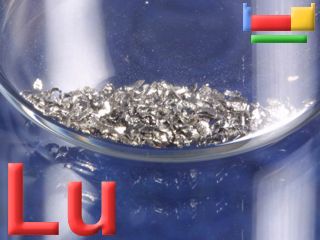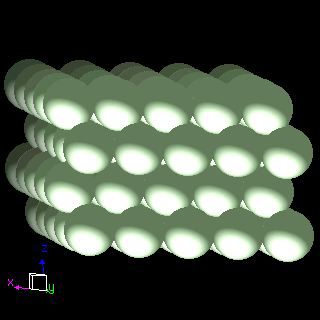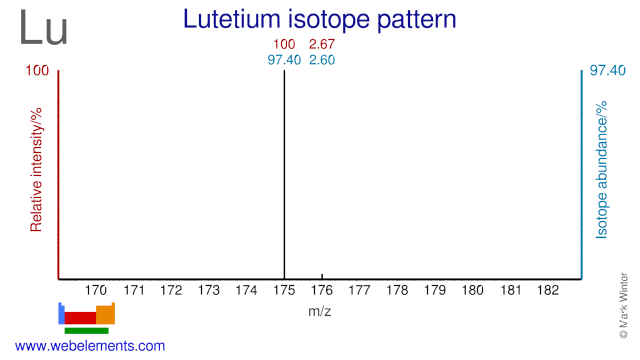Lutetium - 71Lu: the essentials
- Name: lutetium
- Symbol: Lu
- Atomic number: 71
- Relative atomic mass (Ar): 174.9668 (1) g [see note g]
- Standard state: solid at 298 K
- Appearance: silvery white
- Classification: Metallic
- Group in periodic table: 3
- Group name: (none)
- Period in periodic table: 6
- Block in periodic table: d
- Shell structure: 2.8.18.32.9.2
- CAS Registry: 7439-94-3
Lutetium atoms have 71 electrons and the shell structure is 2.8.18.32.9.2. The ground state electronic configuration of neutral lutetium is [Xe].4f14.5d1.6s2 and the term symbol of lutetium is 2D3/2.
Lutetium: description
Pure metallic lutetium has been isolated only in recent years and is one of the more difficult to prepare. It can be prepared by the reduction of anhydrous LuCl3 or LuF3 by an alkali or alkaline earth metal.
The metal is silvery white and relatively stable in air. It is a rare earth metal and perhaps the most expensive of all rare elements. It is found in small amounts with all rare earth metals, and is very difficult to separate from other rare elements.

This sample is from The Elements Collection, an attractive and safely packaged collection of the 92 naturally occurring elements that is available for sale.
Lutetium: physical properties
Density of solid: 9841 kg m-3
Molar volume: 17.78 cm3
Thermal conductivity: 16 W m‑1 K‑1
Lutetium: heat properties
Melting point: 1925 [1652 °C (3006 °F)] K
Boiling point: 3675 [3402 °C (6156 °F)] K
Enthalpy of fusion: 20.5 kJ mol-1
Lutetium: atom sizes
Atomic radius (empirical): 175 pm
Molecular single bond covalent radius: 162 (coordination number 3) ppm
van der Waals radius: 263 ppm
Lutetium: electronegativities
Pauling electronegativity: 1.27 (Pauling units)
Allred Rochow electronegativity: 1.14 (Pauling units)
Mulliken-Jaffe electronegativity: (no data)
Lutetium: orbital properties
First ionisation energy: 523.52 kJ mol‑1
Second ionisation energy: 1363 kJ mol‑1
Third ionisation energy: 2022.27 kJ mol‑1
Lutetium: abundances
Universe: 0.1 ppb by weight
Crustal rocks: 560 ppb by weight
Human: (no data) ppb by weight
Lutetium: crystal structure

Lutetium: biological data
Human abundance by weight: (no data) ppb by weight
Lutetium has no biological role but is said to stimulate the metabolism.
Lutetium: uses
Lutetium: reactions
Reactions of lutetium as the element with air, water, halogens, acids, and bases where known.
Lutetium: binary compounds
Binary compounds with halogens (known as halides), oxygen (known as oxides), hydrogen (known as hydrides), and other compounds of lutetium where known.
Lutetium: compound properties
Bond strengths; lattice energies of lutetium halides, hydrides, oxides (where known); and reduction potentials where known.
Lutetium: history
Lutetium was discovered by Georges Urbain and Carl Auer von Welsbach in 1907 at France, Germany. Origin of name: from the Greek word "Lutetia" meaning "Paris".Lutetium: isotopes

Lutetium is generally considered to have two stable isotopes, although strictly speaking Lu-176 is not entirely stable with a half-life of 3.78 x 1010 years. Lu-175 can be used as a yield tracer in the ICP-MS based determination of Pu in urine. Lu-176 is used for the production of radioactive Lu-177 which is a very promising radio-immunotherapy isotope for the treatment of small, soft tumors. >.
Lutetium: isolation
Isolation: lutetium metal is available commercially so it is not normally necessary to make it in the laboratory, which is just as well as it is difficult to isolate as the pure metal. This is largely because of the way it is found in nature. The lanthanoids are found in nature in a number of minerals. The most important are xenotime, monazite, and bastnaesite. The first two are orthophosphate minerals LnPO4 (Ln deonotes a mixture of all the lanthanoids except promethium which is vanishingly rare) and the third is a fluoride carbonate LnCO3F. Lanthanoids with even atomic numbers are more common. The most comon lanthanoids in these minerals are, in order, cerium, lanthanum, neodymium, and praseodymium. Monazite also contains thorium and ytrrium which makes handling difficult since thorium and its decomposition products are radioactive.
For many purposes it is not particularly necessary to separate the metals, but if separation into individual metals is required, the process is complex. Initially, the metals are extracted as salts from the ores by extraction with sulphuric acid (H2SO4), hydrochloric acid (HCl), and sodium hydroxide (NaOH). Modern purification techniques for these lanthanoid salt mixtures are ingenious and involve selective complexation techniques, solvent extractions, and ion exchange chromatography.
Pure lutetium is available through the reduction of LuF3 with calcium metal.
2LuF3 + 3Ca → 2Lu + 3CaF2
This would work for the other calcium halides as well but the product CaF2 is easier to handle under the reaction conditions (heat to 50°C above the melting point of the element in an argon atmosphere). Excess calcium is removed from the reaction mixture under vacuum.
